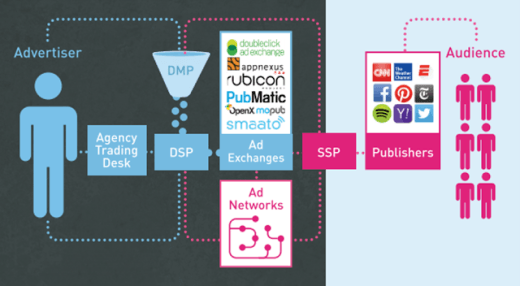If you’re in the digital marketing space and have run across the term Programmatic Advertising, you may have a difficult time finding descriptions that are easy to understand, and don’t require you to already be a digital advertising expert. That’s why we’ve made this beginners guide. Programmatic Advertising is a complicated concept to grasp, so don’t feel discouraged if it takes a little while to wrap your head around it..
To understand Programmatic Advertising, you must first have a basic understanding of the digital ad space and process of buying and selling between advertisers and publishers. For those of you who are new to digital advertising, here’s a quick overview:
Programmatic Advertising
When you’re browsing the Internet, you may notice that ads pop up on the websites you visit. You may also notice that some of these ads directly address your interest. When a website shows you an ad for something that you actually care about, it’s considered a win for programmatic advertising. Here’s how it works:
Graphic Credit: Marin Software.
Many webpages have ad space available. This ad space is bought by advertisers, and sold by publishers. This exchange used to be entirely reliant on humans, but much of the process now has become automated.
Programmatic buying refers to a specific way of buying ad space. The word ‘programmatic’ could easily be switched out for the word ‘automatic’, as it refers to any ad space that’s automatically purchased on a web page through the use of ad buying software. Ad buying software facilitates the ad buying process by using intelligent algorithms to buy ad space. When ad buying is facilitated through human negotiations and manual insertion orders, it is not considered programmatic advertising because it does not rely on software. Programmatic advertising can be achieved through a direct purchase, guaranteeing the ad space to the advertiser immediately, or through real-time bidding.
As mentioned above, before programmatic advertising, the process was manual and required constant buying and selling of digital ads by human ad buyers and salespeople. Advertisers used to have to research the behavior of website visitors, decide on the value of ad space, and make a manual bid for the space. This was a time-consuming, laborious process that often resulted in under optimized campaigns. In short, it turned out to be an expensive and unreliable system.

Human exchanges also leave room for human error. The biggest risks for advertisers included buying ad space for too high of a price, and buying space that didn’t expose their ads to their target audience. The risk for publishers included the risk of charging too little for their space, or selling the ad space to advertisers that would present ads that were totally irrelevant to the audience that landed on that site.
With programmatic advertising, the use of high-tech software ensures that advertisers are protected from human error by using a series of high-tech algorithms to help assure that the right ads will be seen by the right audience for the right price. Programmatic advertising does not remove humans from the equation altogether, but it removes them whenever possible. This makes the process more efficient and cost-effective and frees up funds and resources for both advertisers and publishers.
There are two types of programmatic advertising: Programmatic Direct, and Real Time Bidding (RTB).
Programmatic Direct
Programmatic Direct is when ad space is purchased in advance from a publisher. This guarantees that an advertiser gets that specific ad space. This is an automatic ad buying process that does not require an auction. When programmatic direct is used, the price for the space is based on a specific number of required impressions and demographic information from the site.
The greatest benefit of programmatic direct is that advertisers can target their ad to the specific audience of that webpage, and quickly change the ad if the ad is not performing or if the audience changes. Their design, images, and messaging can be very targeted and specific to the audience of the website, which can be a powerful tool for advertisers.

Real-Time Bidding
Real-time bidding is when ad space is fought over by different advertisers in a real-time bidding war.
Every time a visitor lands on a site, their information is collected. The value of collecting that information is that it provides insight about the demographic that visits a particular website. Information such as age, gender, and browser history can be collected.
This information is used to give advertisers insight about the visitors to a particular web page. If the demographics align with the advertiser’s target audience, that space is considered valuable.
Real Time Bidding contains a few components.
Demand Side Platform (DSP):
Think of Demand Side Platforms as a middleman between advertisers and ad space. Demand side platforms help advertisers manage their ‘demand’ – their ad campaigns they want to be published. Demand Side Platforms provide technology to help advertisers buy ad space. They make it easy for advertisers to manage their ad campaigns and get their ads in front of the right audience for the best price. DSPs remove the need for continual negotiation and tedious wading through complicated data. Demand Side platforms are geared toward making life easier for advertisers
To help you understand this relationship between DSPs and advertisers, it helps to think of DSPs as what they would be if they were humanized: An advertiser’s world-class personal assistant. The advertisers know they want their ads placed in the right places to be seen by the most relevant audience, but they don’t want to do the grunt work by hand. Advertisers want to say what they want when they want it, and have their assistant make it happen. Working as a ‘personal assistant’, DSPs do all the work to make sure their advertiser’s best interests are taken care of. They poll information to research audiences, fair pricing, and available inventory, then they make a bid; they do it all faster and more accurately than any human personal assistant could.
Ad Exchange
Ad exchange is where Supply Side Platform and Demand Side Platform interact. It’s a digital marketplace that gives advertisers and publishers the ability to buy and sell advertising space, managing supply and demand for ad space. This is where the action happens.
For example: Think of the Nasdaq Stock Market. The Nasdaq is a platform that allows people to buy and sell stocks easily. An Ad-network, or Ad exchange, does the same thing for ad inventory; it allows users to buy and sell ads online, acting as a mini-marketplace.
Still Confused? Watch this video.
Here is the process for Real-Time Bidding (RTB):
- Publishers make their ad space available by posting their ad inventory on an ad exchange via Supply Side Platform.
- Advertisers determine their target audience for each campaign and define their audience and budget for campaigns on an ad exchange.
- When a visitor lands on a web page, their information is loaded and reported back to the ad exchange.
- If the demographic information of that website matches the target audience for an advertiser, their bid for advertising space is placed.
- The advertiser with the highest bid is given the space during that visit, and their ad is presented for the entirety of that visit.
This process takes place during the short time it takes to load a webpage.
Experts predict that programmatic advertising, and the technology that supports it, will continue to grow and give advertisers and publishers and increasingly more intelligent solution for managing digital ad campaigns.
Still Confused? Watch this video
At Fujisan, we have experience managing all areas of digital advertising, including programmatic advertising. If you’d like to learn more about what we can offer, click the link to reach out.





